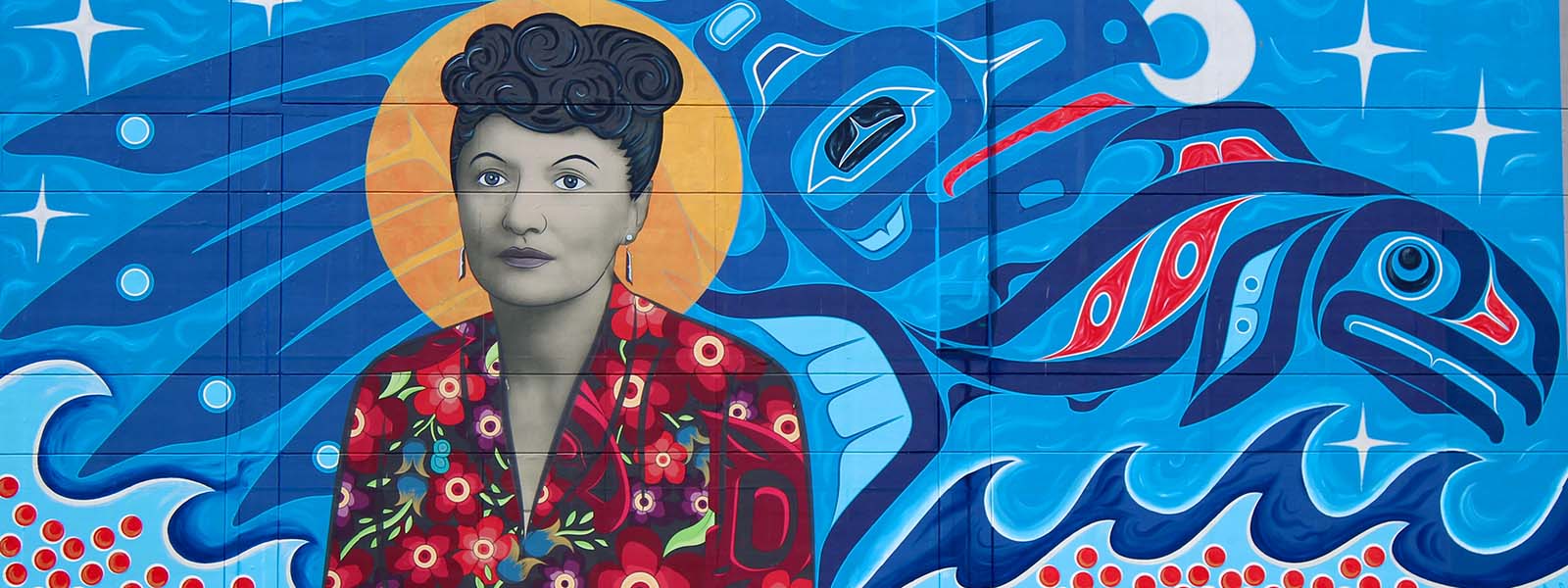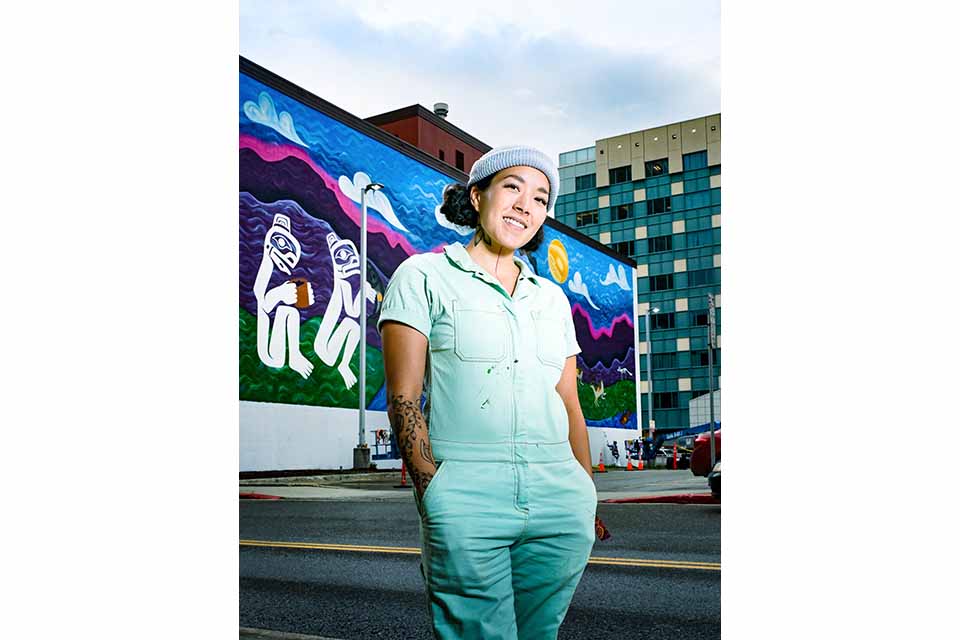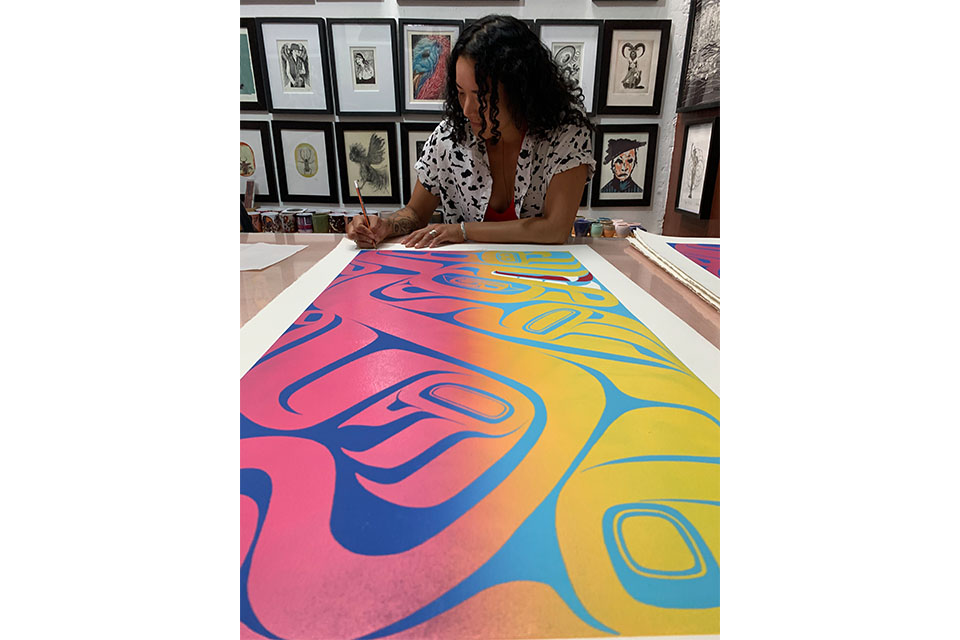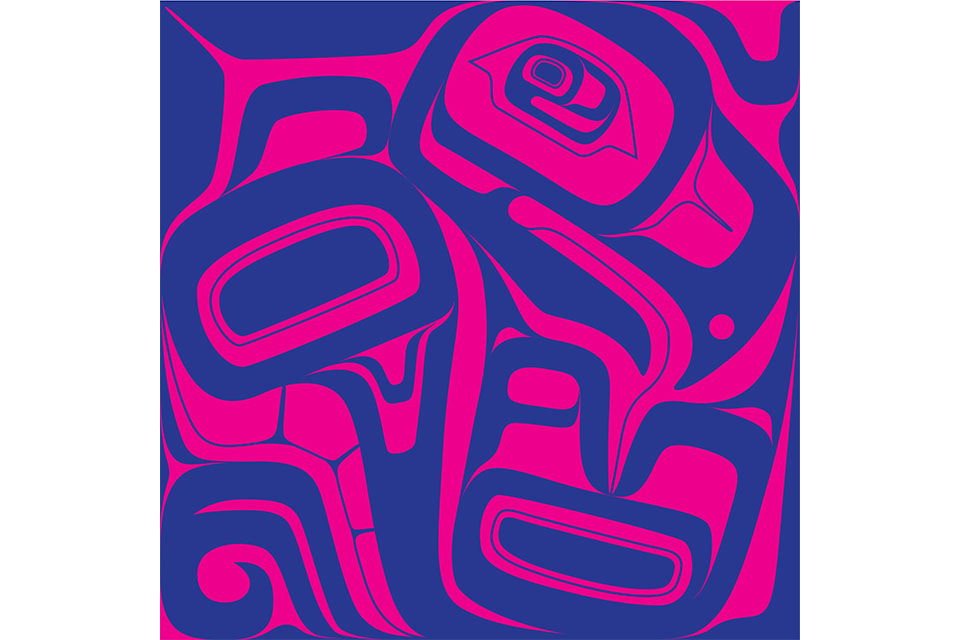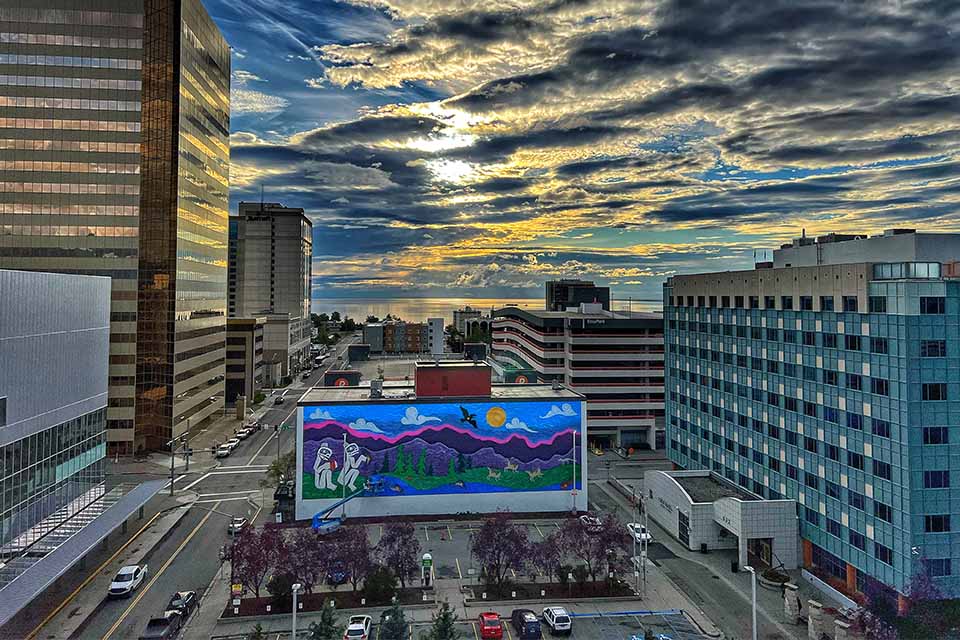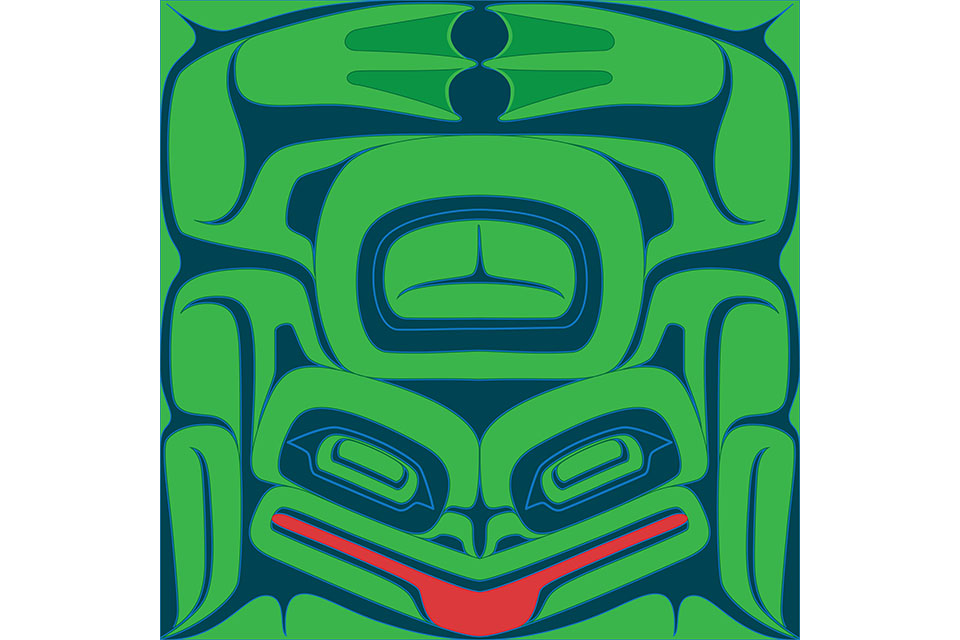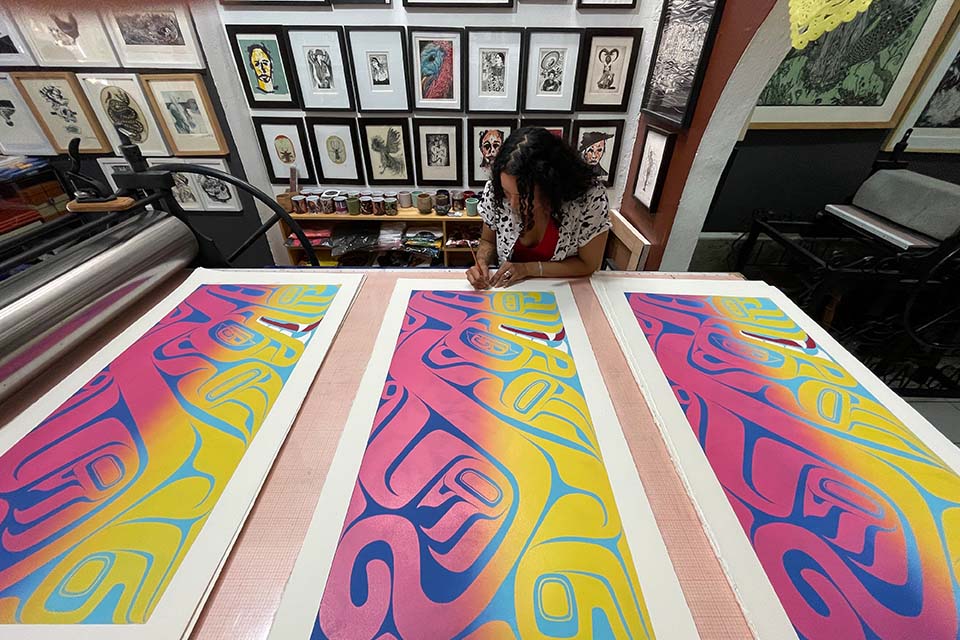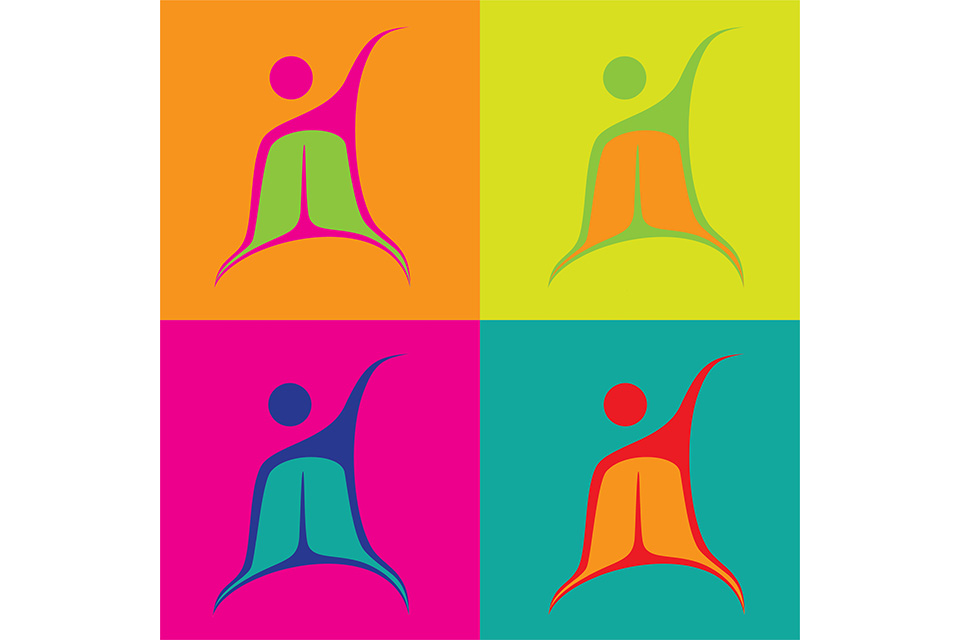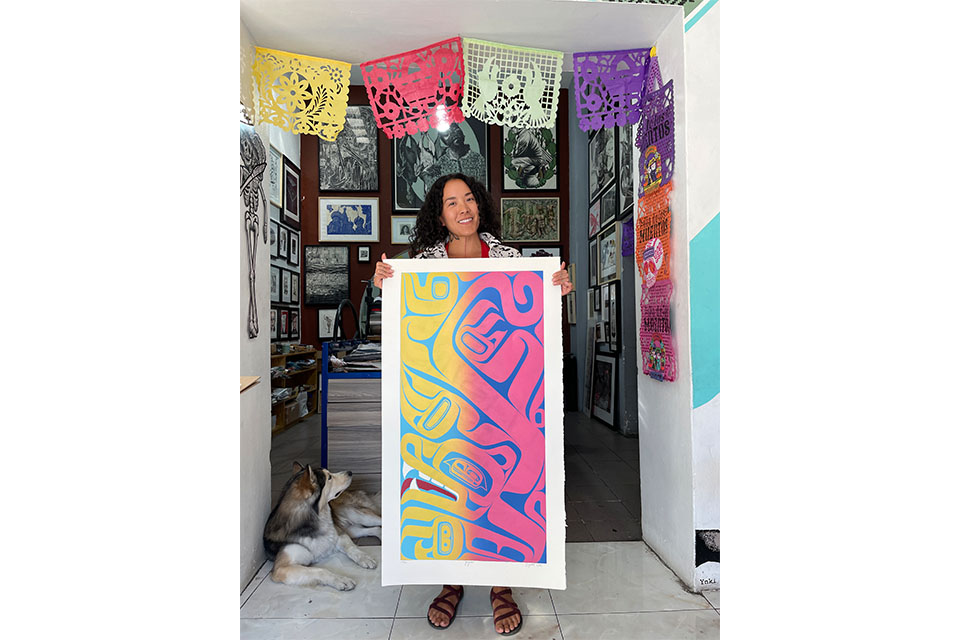Crystal and Rico Worl
The views and opinions expressed by speakers and presenters in connection with Art Restart are their own, and not an endorsement by the Thomas S. Kenan Institute for the Arts and the UNC School of the Arts. This interview has been edited for length and clarity.
Siblings Crystal and Rico Worl have been making art together in Juneau, AK since they were children, and as adults, not only are they thriving as professional artists, they also co-own a successful online business, Trickster Company, whose mission is to promote innovative Indigenous art.
Members of the Tlingit and Athabascan tribes, Crystal and Rico continue to explore the cultural traditions of their heritage, studying at length with master craftsmen and artists, and the formline style prevalent in the Pacific Northwest lies at the heart of their practice. However, whether using new technology in their art or applying traditional design to everyday objects from basketballs to playing cards — Trickster Company is currently featuring the “Cards Against Colonialism: Western Expansion” set — they remain committed to keeping Indigenous art a living, breathing and evolving cultural touchstone.
The scope and reach of their work continue to expand. In July of 2021, the U.S. Postal Service issued the Raven Story stamp bearing a Rico Worl design, and in the last year Crystal has painted two enormous murals – one in Anchorage, the other in Juneau — that with striking vibrancy counteract a long tradition of whitewashing Alaska’s history.
In this interview with Pier Carlo Talenti, Rico and Crystal delve into the many ways they are working and playing together and apart to ensure that all Alaskans, as well as the millions of visitors to the state, learn to celebrate the value of authenticity.
Choose a question below to begin exploring the interview:
- How would you describe each other's artistic journey up to now?
- How do you balance tradition and modernity? Are there ever moments when you feel you’re going too far either way in your art or your commerce?
- How did you go about developing your business idea and figure out what it was going to be?
- Is part of your mission also to educate the general public about what is authentic?
- What have you enjoyed about public art, and what’s proved to be most difficult?
- What current or upcoming project are you most excited about?
Pier Carlo Talenti: Given how well you know each other, I thought it might be fun for each of you to describe the other’s artistic journey up to now.
Rico Worl: OK, I’ll start. Growing up with Crystal, I always knew she was an artist. She played a lot of the roles of artists, painting and drawing and everything forever, and so it was cool to see her development over the years. Eventually she ended up going to Institute of American Indian Art to get her degree and start her professional career with art.
After that, we both came to Juneau around the same time — I got there a little bit earlier — and we started our business, Trickster Company.
Pier Carlo: Rico, you’re the elder of the siblings?
Rico: Yes.
Pier Carlo: Was it strange to have another artist coming up behind you?
Rico: I actually didn’t consider myself an artist until a number of years after starting Trickster Company.
Pier Carlo: Oh, how come?
Rico: I was doing mostly design work and product design, and I dabbled in other creative things, but art … Creativity is integral with the culture, so sometimes it doesn’t necessarily feel like you’re being an artist or being creative; you’re just engaging in your culture. It wasn’t until X amount of people were like, “Oh yeah, you’re an artist,” that I was like, “Oh, OK.”
Pier Carlo: Crystal, did you think Rico was an artist before he thought he was?
Crystal Worl: Yeah. I remember growing up, we used to play. Our toys were construction paper. We discovered we could make popups on our own with scissors, construction paper, glue and crayons. We built this little town out of paper, and we’d make these little shops. We had a bookstore, and we’d illustrate all the little pages of the books. We even had a little clothing store. Then we’d have our Hot Wheels cars that we’d play around with. Our younger brother, Kyle, would play with us too, and I always recognized that both my brothers were creative in their own ways. Growing up with Rico, I’d always see him drawing and taking interest in creative things.
But like Rico said, it’s inherent in our culture of growing up Native. When my mom was showing me how to bead, it wasn’t like, “We’re doing art.” It was just a part of spending time together, mother and daughter.
Rico went to college at UPenn to get a degree in anthropology, and then he got a job in Juneau, working to repatriate a lot of our Tlingit artifacts and our Chilkat robes from museums, which is super badass. Then after his eight-hour workday, I’d visit him in his office, and we’d practice speaking Tlingit together, and then he’d practice playing his guitar. Then he started working on designing, and that’s when he started a Kickstarter for designing playing cards that would eventually fund the Trickster Company business opening up and having a brick-and-mortar in downtown Juneau.
At the time, I was finishing college, and I took this business course in which I wrote this business plan to open up a gift shop in downtown Juneau. Simultaneously he had written something very similar, but we didn’t tell each other about it or talk about it. Then, he was like, “I got to show you something!” and I was like, “I got to show you something!” And then after I graduated, we swapped business plans. Of course, his was a lot more thorough and a lot more logistic. Mine was just creative and “la la la,” but we were like, “Oh, I guess we’re going to do this.”
That’s when he started doing the Kickstarter, and that’s what got our shop first open. Once I finished school, I moved to Juneau and helped him open up Trickster.
Pier Carlo: We’ll circle back to Trickster Company later. Before we go there, I want
to talk about what you were just saying, namely that a lot of the art you do is so
culturally ingrained. The work that you do is very much steeped in tradition, and
yet you’re also making art and items that are very much for a 21st century audience
or consumer. How do you balance tradition and modernity? Are there ever moments when
you feel you’re going too far either way in your art or your commerce?
Rico: I don’t ever feel like there is a way to go too far with that.
Crystal: I’m always like, “Am I going far enough?” [She laughs.]
Rico: [Laughing] I like that, yeah.
I think creating Indigenous art isn’t something that is time-based or era-based as much as culturally based. Cultures are living things, so as a living culture and as a living people, there’s no way that anything that Crystal or I make isn’t going to be somewhere along the lines of Tlingit or Athabascan art.
Pier Carlo: Crystal, what did you mean when you said you wonder if you take it far enough sometimes?
Crystal: It feels weird to say there’s a possibility of being too Native. [She chuckles.] I guess I’ve heard of people saying things like “not Native enough,” but that’s a really negative comment that I definitely don’t give energy to.
I have fun living in two worlds, being Tlingit and being a modern Tlingit person. I think it’s really cool because I can dive into playing with laser-cutting. Rico does 3D-printing and CAD. I love that I can do painting but with colors that are really fluorescent and neon. And printmaking. I can fly somewhere across the world and study printmaking. I did that last winter. I went to Oaxaca City, and I did a study of printmaking and woodblock color-printing and made a really cool print with a really different spectrum of colors that I chose from being in Mexico. The color palette there is very different, but I used formline design and my studies in classical formline to create a design. I think it’s really fun seeing what I can do.
And then stepping into public art. I’ve designed these resin panels, different methods of applying murals. There’s just so much science and technology and abundance of learning and trying new things. It’s actually frustrating; I don’t have enough time in this life to try everything. Rico and I have this joke that we like to try everything and we’re just OK at everything. We’re not good at one thing because we can’t seem to sit still and get really, really good at one thing. We want to try all the things, and so we have this joke that we’re both just OK at everything.
Rico: The nice thing about that, though, is we can also skill-share. Crystal’s much more interested in and better at painting than I am, but I’m much more interested in and better at CAD than she is. So we can exchange ideas and visuals and collaborate on things that help us explore different techniques that we’re not individually ready to dive into and invest in. But I’m still able to explore those visual opportunities.
Pier Carlo: I saw an interview with Crystal in which she was talking about the mural she just created. Apparently the design of the earrings and something else in the design came from Rico, right?
Crystal: Oh yeah. That’s the mural I did in Juneau. It is to commemorate Elizabeth Peratrovich. It’s her portrait with her clan behind her in formline, the Raven Sockeye, the Lukahaadi Clan, which is also our clan, so there’s a perfect match to commemorate her. I used this really iconic old photo of her from the State Museum archives and took that photo and superimposed it in Adobe Illustrator. Rico taught me how to do Adobe Illustrator first, and I’ve been using it and learning on my own ever since. I used Adobe Illustrator to superimpose that photo. She’s wearing this button-up floral-pattern shoulder-padded shirt, and I changed the pattern to be Rico’s pattern that has formline salmon and Athabascan beadwork pattern on it. Then I put a pair of his engraved silver baleen earrings on her as well because I was trying to deck her out in what she might wear now but not change the photo so much.
Pier Carlo: I want to talk about that moment when you both realized you had the same business idea. How did you go about developing it and figure out what it was going to be?
Rico: I got a little bit of a head start on her because I was home first after college. The very first thing I started out with was one of my hobbies that I had when I came home. I was taking up longboarding, and I painted my Yéil clan crest onto the longboard simply because I just wanted to represent my daily life, more of my identity. That caught people’s attention when they saw it, so I ended up painting a few more, one for my cousin for one of his birthdays, and then his cousin wanted one. I think the idea of representing Indigenous identity in your day-to-day life was something that people were really drawn to.
I started with Trickster skateboards and manufactured a set of skateboards and used that name. Eventually I realized that skateboarding was an interest but wasn’t necessarily the passion that was at the core of what I was doing as much as designing those products were. It became very apparent when I was like, “OK, I want to design a deck of playing cards now,” and it wasn’t really a skateboard. I was like, “They’re both decks,” [he laughs] but that wasn’t enough to hold up the name, so I was like, “OK, I’m going to change it to Trickster Company.”
Pier Carlo: And where does the name Trickster come from?
Rico: Raven is a trickster-type character in a lot of our traditional stories, and one thing I appreciated about Trickster is the idea of play. Crystal mentioned a lot of our creativity came from play when we were growing up, and I would say even nowadays that when she mentions my sketchbook and she’s just in there laughing at random things, that’s all play. To me that’s all play with ideas, play with concepts. I even have a tattoo that’s almost just about the idea of play. Ravens are very playful creatures that I felt embodied the idea of play and the way that it encourages creativity.
Also Raven is one of the two moieties in Tlingit society, moieties being social halves. You’re born into your mother’s side, so you’re either Eagle or Raven, and we’re Raven. That also played into it. There’s multiple points of entry for the idea of Trickster Company being the name of our company.
Pier Carlo: So the playing cards were the official beginning of the business?
Rico: Yeah, yeah, that’s when I officially changed the name to Trickster Company. We got the playing cards funded through Kickstarter, so it was our first capital investment. Playing cards, especially the quality that I wanted, you have to manufacture them — you can’t just do small runs of them — so it was a first major manufacturing process I went through, and it opened the doors for creating the wide range of products that we create today.
Pier Carlo: Crystal, could you talk about your involvement in the company? At what point did you really dive in?
Crystal: Let’s see, I moved home and basically jumped in when we started building the shop. I just helped promote Rico and his Kickstarter and played follow-the-leader with his branding, his ideas.
Pier Carlo: When you say building the shop, you mean the brick-and mortar shop or a studio?
Crystal: The brick-and-mortar shop. We rented a little shop that used to be an old photography shop downtown, and we had to rip out the ceiling and the floor and the walls and totally transform the space. I came and helped with that. Then once we got the shop open, we had empty shelves, just a bunch of playing cards. [She laughs.] People came in, and they’d be like, “Oh, it’s a magic shop. There’s cards here, and it’s called Trickster.” And we’re like, “Not quite. Just give us a little while. We’ll have more things than playing cards, but we’re not a magic shop.”
I just jumped in right away on creating designs. I started with pulling little prints that we’d sell in the shop and trying to do paintings as quickly as I could so that we had more stuff on the shelf. A lot of our shelving was just playing cards and handmade little doodads that I started making when I moved home.
We didn’t have a studio yet. We were living together, and our living room was the warehouse, and I was sleeping on a futon between boxes. It was also our studio space. I was trying to paint and print-make in between boxes, and it was just this chaos and made it a little bit stressful of a living situation, but it was totally worth it because I was just really, really excited about what we were doing. And a lot of people were really excited for us.
Because a lot of the shops downtown Juneau are owned by cruise ships, and they sell a lot of little dinky things that are made overseas and historically have made a lot of knockoff Native art, like little totem poles made in Bali that are shipped overseas, just really wildly inappropriate things sold super-cheap in these stores that mostly are not locally owned. There was just really poor representation and support for actual Indigenous artists. Part of Trickster happening was that people were like, “What is this?” So it was really exciting.
Pier Carlo: And then you decided to move entirely online. Was that during the pandemic?
Crystal: Yeah, when the pandemic started, the cruise ships were basically severed from coming. Our lease was up, and we were just at a point where, “Oh this is a blessing in disguise because it’s a good time for us to transform.”
Rico: Having a Native-owned shop was a symbol for us in a town with so much knockoff art, so that was tough to let go of. But in the end Crystal and I are passionate about making stuff more than we are about running a shop, and selling primarily online allows us to dive more into that passion.
Pier Carlo: You’ve mentioned knockoffs a few times. Is part of your mission also to educate the general public about what is authentic?
Rico: I’m going to answer a previous question with different words this time and work my way towards that.
Another reason that I didn’t consider myself an artist is because, as Crystal mentioned, I got my degree in anthropology, and when I came back, I was working for our tribe and doing some repatriation and some developing of arts programs for Southeast Alaska. A lot of what I was doing was creating programs to address some of the issues of tourism creating this market for knockoff work. Some of it was trying to support Native artists as they developed their skillsets, both technically within their artforms as well as technically with being a business owner, so how to support yourself with your art more. It was social-based work.
When I started creating designs, they were all with those same goals of supporting Indigenous arts through design. The playing cards weren’t necessarily because I was like, “Oh this will look nice or be cool.” The playing cards came about because of that knockoff market and approaching it from a new angle. Maybe we can’t exactly compete within that market with a hand-carved mask. Right now, there’s very little ways to compete with knockoff stuff. So maybe I can focus another direction and be like, “OK, I want to make playing cards, which are in a lot of shops, but they could buy it, and it could be authentically designed and at a manufacturing level that meets the market need.”
A lot of what I was doing was creating options for these places that were supporting knockoffs to support the authentic. There is an aspect of educating, but there’s also creating new opportunities for them to be able to support authentically.
Pier Carlo: I want to talk about the public art you’ve been making. Crystal, you mentioned earlier that now that the business is online, you have more time to explore new things, including public art. But that also means you’re working on a totally different scale and you’re navigating a whole new slew of bureaucracies.
What have you enjoyed about that kind of work, and what’s proved to be most difficult?
Crystal: I guess what I really enjoy about public art is that the end piece is really gratifying. One, it’s finished, and it was a lot of blood, sweat and tears put into it to get to that point. And the most rewarding part is the people in the community that receive it and getting their feedback. Before the process, I work with different community members, and I have apprentices, and I interview cultural leaders and try to be inclusive as much as possible all the way through the process, through to the end and after.
The biggest reward is the people that give me thanks. With the Elizabeth Peratrovich mural, it’s really wonderful that I get a lot of requests from the Alaskan Native Sisterhood to reuse the image to help promote their cause and support their fundraisers. It just seems to continue to give back in a way I didn’t expect. One of Elizabeth Peratrovich’s family members called me from Prince of Wales — she was really elderly, about 90-something — and she just gave me thanks and talked to me on the phone for a long time. She was really cute. She said, "I want to come visit. After COVID, I’m going to come visit you." And I was like, "Please do." And she’s like, "I’m going to come visit just so I could see the mural. I should also mention I’m blind, but I just want to be in the presence of the mural." And I was like, “Whoa, that’s like the best compliment I’ve ever received!”
Pier Carlo: Yeah, really, you can just pack it up and end right there! That’s amazing.
Crystal: Just the amount it’s shared. It doesn’t belong to me. It belongs to everyone, a community of people, and it helps warm our community and bring more diversity and representation of color.
It’s kind of like the shops in Juneau. A lot of the public art in Alaska has historically been very lacking of representing Indigenous artists, and there’s such an amazing amount of variety and talent in all the different cultures in Alaska. It was really frustrating to see a lot of out-of-state artists who are really wealthy get an opportunity to create public art in our community. I was like, “There’s so much local talent.”
Rico was a really big part of getting me into public art, because he was the first one to start going into public art. Then he pushed me towards it, and I just embraced it fully. Now I am applying it to bigger scales like murals and applying my painting to it.
But yeah, public art is not easy. The applications are 30-something pages and they’re all in engineering terminology. They’re really intimidating for a lot of locals. It’s kind of grueling to work through the process of getting it passed, convincing all the city and state and assembly. I had to put on this face where I was engaging with a lot of politicians and influential people in the community. I didn’t really have to do that before when I was hiding in my studio. Now I’m literally up on a lift 15 feet in the air and applying this mural. The Anchorage mural is like 120-something feet by 48 feet. It’s massive.
And I’m really good at operating lifts now, and that’s really satisfying. It was really scary at first, because right before I start a mural, I get really, really nervous. I have moments where I cry about it, and I’m like, “I don’t know what I’m doing,” or, “I don’t know if I can do this. I can’t pull out now.” There’s a lot of pressure about the design.
This one in Anchorage, I was covering up an old mural that had been there for nearly 30 years. The old mural was done by an artist who no longer lives in Alaska. We couldn’t get ahold of him; I don’t even know if he’s still alive. He did this very monochromatic depiction of Anchorage’s timeline history. There’s a lot of airplanes that were on it. It was basically acknowledging Anchorage’s white history. There’s no acknowledgement of indigenous people. And it was a very linear timeline with numbers. It was just past due to put a new mural up.
I think one of the hardest parts was getting a lot of public ridicule and almost feeling discriminated for covering this piece. My partner deleted my Twitter while I was doing the mural because there is this feed that was just people saying the nastiest and most ridiculous things. I’m back on Twitter, and I was like, “OK, it was good that I took a break from social media while I focused on getting the mural done.”
I’ve been working on the mural for two years, and the actual application of the mural took three weeks. It was raining, it was windy, it was cold, it was foggy, it wasn’t ideal weather, but we got it done underneath the massive amount of time and pressure and the elements and my fingers being so cold I couldn’t bend them. And people jumping over the barricades to yell and literally go under my lift and be like, "Hey, I just have one question. It’ll take 30 seconds." That, times 100 different people. I’d try to keep my headphones on and just play some music.
After I read some of the comments on Twitter, I was like, "You know what? I’m going to put my phone down. I’m going to do my hair fun, and I’m going to wear a crazy, crazy outfit and just play the role super-hard of, 'I’m a crazy artist.' Call me these things and I’ll embrace it."
I’m doing a painting now because someone said pink is not a native color. That is such a ridiculous comment to me that I have decided to make a painting called “Pink is Not a Native Color.” I found the brightest, hottest pink I could possibly find to paint the majority of this painting with this color. And I’m really excited about it.
Pier Carlo: Rico, what current or upcoming project are you most excited about?
Rico: Crystal talked about her move into public art and large-scale art. With the little bit of flexibility that we’ve gotten, I’ve moved into trying to learn sculptural formline. A lot of our artwork, if you look at it, it’s on a two-dimensional plane, and formline in that form is a certain way. And then of course there’s sculptural formlines, so you think of totem poles or house posts, that kind of thing, which is formlines still but just in three dimensions. It’s a lot to learn, and so I’ve been really focusing on trying to learn that. I’m working with Jackson Polys, who’s from Ketchikan and has done quite a bit of sculpture over the years. I’m helping him carve a totem pole right now.
Carving is not really my primary interest, but it’s a good way for me to learn, and it’s the traditional medium for 3D formline. At the same time, I’m learning how to digitally sculpt. The majority of my time is being put into that right now. I just got a grant from Juneau Community Foundation to create a bronze sculpture with an augmented reality artwork over it. You’ll be able to see the sculpture in person, and then when you put your phone over it, you’ll see an animated digital art overlaying and interacting with the physical art piece.
Pier Carlo: Crystal, what about you?
Crystal: Tomorrow Google is launching my artwork on the Google browser and the Chrome browser in honor of Native American Heritage Month. They’re featuring a handful of Native American artists, and my art will be on the Google Chrome browser starting tomorrow.
Pier Carlo: That’s incredible. Congratulations!
Crystal: Thanks. I’m really excited about it. I really love the direction I took the art. It’s a bit different. I don’t typically include portraiture or self-portraiture in my art. I did this time because if you Google “Native American,” a lot of what comes up is Edward Curtis photography of old Natives in headdresses and posed, just a Native person, Sitting Bull, or really old photographs of stoic-looking Natives looking super-Native. [She laughs.]
But if you Google any other ethnicity, it shows modern people dressed in modern clothing and what they look like. So I thought it’d be cool to include some of my, “What does a Native American in the modern day look like?” I’m really excited for that to happen tomorrow.
November 09, 2022






